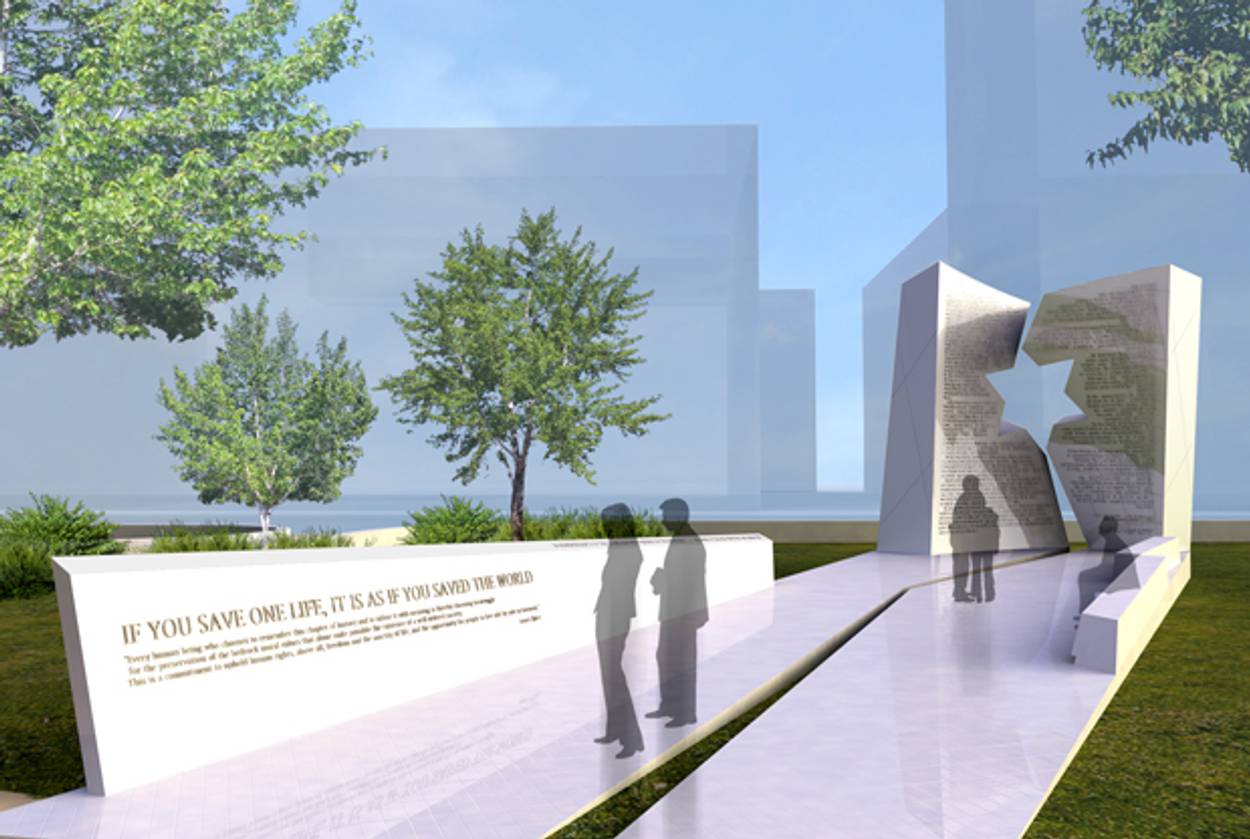Daniel Libeskind Design Mocked in Mock-Up
The latest in Ohio’s Holocaust memorial fight




When famed architect Daniel Libeskind, the child of Holocaust survivors, learned earlier this year that he was one of three finalists chosen to submit designs for the Ohio Holocaust Memorial, he was thrilled.
“This is not just something abstract for me,” he told me in February. “It’s something I’ve been thinking about my whole life—how to memorialize the extermination of millions of Jews but at the same time give inspiration to the future.”
In May, Libeskind’s submission—featuring two angled 18-foot steel panels, embossed with the story of an Auschwitz survivor, and joined together by a cut-out in the shape of a Star of David—was chosen as the best design by the Holocaust Memorial Arts Selection Committee, made up of members of the Ohio arts community, members of the Capitol Review and Advisory Board, Holocaust survivors, and a World War II veteran. (The memorial will be funded by private donations, but the site preparation will be paid for by the state).
The Capitol Square Review and Advisory Board, which controls the House grounds, is set to have a final vote today approving the artist and monument. But on Wednesday, they arrived at the Capitol to a surprise: A crude mock-up of Libeskind’s design, made of plastic pipes, barrels, and tarp, with a large blue Jewish star spray painted in the middle, had been put up on the state grounds. (The Star of David has since been removed.)
The mock-up was commissioned by former Senator Richard Finan, the head of the Capitol Square Review and Advisory Board, who has long opposed putting a Holocaust Memorial on State grounds. “A Holocaust memorial does not fit with the historical markers of the State house,” Finan told me in February. “Our statues are all about Ohio’s civil war generals … I do not think a statue or monument to the Holocaust belongs in the Statehouse. There are other more viable places it could be put.”
Finan warned in February that if the state went forward with the memorial plans, they would get sued. Apparently, Finan felt that the public was not hearing his message—so he decided to illustrate it with a hastily constructed mock-up of Libeskind’s architectural plans. He told the Columbus Dispatch that he ordered the sculpture constructed by state employees because he “wanted people to see what the memorial will look like in that location.” (Finan did not return multiple phone calls seeking comments).
To supporters of the monument, the mock-up seemed a direct insult to the memorial’s purpose. “I did not know about this beforehand,” said Representative Steve Slesnick, who sits on the Capitol Square Review and Advisory Board. “When I saw what it was, I was very upset. It’s a mockery. The stuff was thrown together to emulate what the monument is supposed to represent: a memorial and tribute to the six million Jews who died during the Holocaust and a tribute to the survivors.”
And when Libeskind heard about the design, he was furious. “I have had nothing to do with what was assembled. It is a clear misrepresentation of my design which was presented on May 6 and approved by the artist selection committee,” he wrote in an email.
Finan has at least one supporter in his fight against the monument: the Freedom from Religion Foundation, a Madison Wisconsin based non profit organization committed to protecting the separation of church and state. In June, the foundation sent the Capitol Square Review and Advisory Board a long letter opposing the monument. “FFRF believes with the state of Ohio it is important to memorialize the Holocaust,” they wrote. “We also believe that the solemnity and import of the task can be accomplished without permanently placing a religious symbol on government property. As the Star of David was deemed by European Jews to be the symbol that ‘would represent Judaism just as the cross did Christianity’ its prominent inclusion in the memorial gives the impression of an endorsement of Judaism.”
They added that the memorial “ignores the fact that there were other victims of the Holocaust” and it “gives the impression that only the Jewish victims of the Holocaust are being honored by the state.”
The Freedom from Religion Foundation sent out action alert emails to their members, asking them to protest at today’s meeting. There are thoughts of possibly filing a lawsuit against the state, said Rebecca Markert, the staff attorney for the organization. “We are waiting to see what the Board decides to do,” she told me.
Representative Armond Budish, former speaker of the House, finds these threats baseless. “I’m a strong supporter of the separation of church and state and I don’t see this as a violation,” he told me, adding that, “I don’t see how a memorial recognizing the mass execution of millions and millions of people is a religious expression. The memorial’s recognizing a historical fact that millions of Jews were killed in the Holocaust.”
And Slesnick, the Representative on the Capitol Square Review and Advisory Board, said he’s not worried about today’s vote approving the artist and design. “I don’t think there will be any problems,” he said. “This is a no brainer vote.”
Previous: Ohio’s Holocaust Memorial Fight
Rebecca Meiser is a freelance writer living in Cleveland.